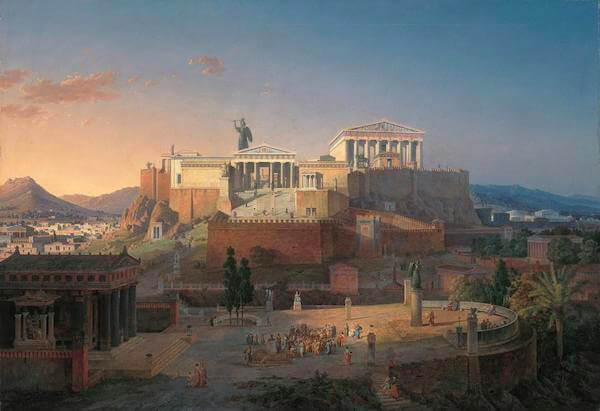
It’s one of the most well known ancient cities in the world. While you’re in Athens, all you have to do is look up to see it standing proud towering the city. An ancient citadel, the Acropolis of Athens (Ακρόπολη Αθηνών) can be dated back to around 4000 BC; however, what we see today took shape around the 5th century BC. Most of the buildings we know and love, like the parthenon, can be attributed to the leadership of Pericles, who coordinated the construction of the buildings that currently stand. Other key people involved were Phidias, an Athenian sculptor, and two well known architects at the time, Ictinus and Callicrates.
If it will be your first time in Athens, taking a day out of your schedule to spend at the Acropolis is a must. While visiting, there is a lot to discover, so we’ll go over the sites and give you a general overview of what you can expect to see.
Note: At over 2000 words, this post is a bit long, but it’s got a lot of pictures to keep things interesting 🙂
Alright, let’s get started!
First, the word Acropolis comes from the Greek words ἄκρον (“edge”) and πόλις ( “city”), so when someone mentions the word, “Acropolis,” they are talking about a location, a group of buildings, not just one.
When you arrive at the top of the hill, you will be greeted by a grand entrance to the Acropolis, this is called that Propylaea (Προπύλαια).
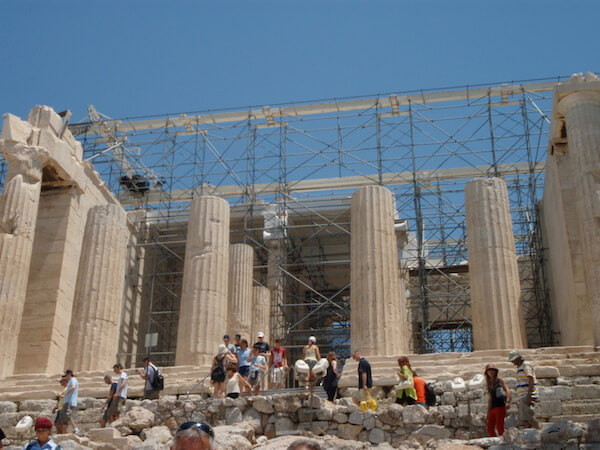
This magnificent towering entrance must have been an incredible sight to see. As you stand before it, imagine how many people have stood there and passed under this structure as you soon will. People like Alexander the Great, Plato, and Socrates just to name a few. It’s truly a unique feeling shared by history buffs and every day travelers alike.
Here is a drawing of what it might have looked like (you can see the next building we will discuss, The Temple of Athena Nike, off to the right).
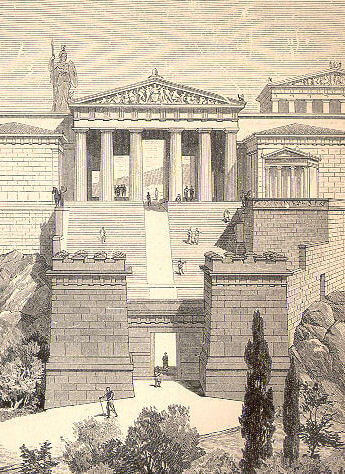
As you move forward, you’re actually walking on what is said to be the main entrance, or the sacred way, which will lead directly to the Parthenon. There use to be two additional entrances on each side, five total, that granted people access.
As you approach, you can look to your right and see Temple of Athena Nike (Ναός Αθηνάς Νίκης).
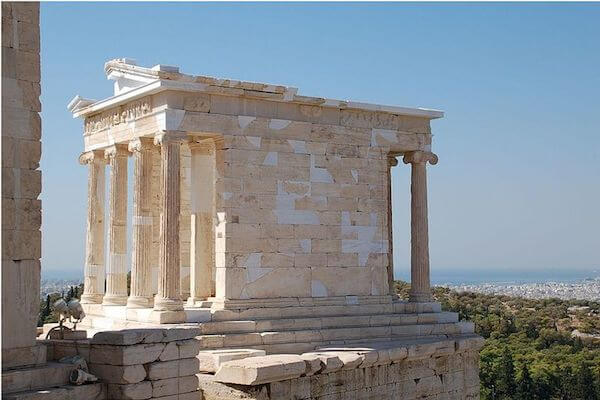
Built between 427 and 424 BC, it is the earliest fully Ionic temple at the Acropolis. The Temple was built over the remains of a 6th century temple dedicated to Athena, which stood until the Persians demolished it in 480 BC. The new Temple of Athena Nike stood 23 feet high and consisted of a state located in the cella (center of the temple).
What is interesting here is that when the statue of Nike (Goddess of victory) was constructed in the cella, it was built without wings. Previously, the goddess, Nike had wings and was known as the “winged victory,” yet the statue located at the Acropolis was called, Nike Apteros (wingless victory). And why was she built without wings? They say it was so that she would never be able to fly from the city and thus Athens would always remain victorious, or at least have the goddess of victory by her side.
Let us now pass through the Propylaea and come out the other side to a magnificent view. To the left will be the Erechtheion, which will cover shortly, and up ahead to the right something you’ll no doubt recognize. There she stands in all her glory. You may have seen her in school books, history class slides, or on TV, but nothing can create the impression of seeing this building in person for the first time (or the 2nd, 3rd, or 4th). Yes, I’m talking about the Parthenon (Παρθενών).
As you approach, you’ll notice large stones on the ground, and roped off ruins to your right. What stood there at one time was the Brauroneion, a sanctuary dedicated to Artemis (Ἄρτεμις). Past that, and standing diagonally from the Parthenon, was the Chalkotheke. Not much is known of that building. Passing those ruins, you’ll now be standing right in from of one of the most recognizable and magnificent buildings of the Ancient world.

I remember the first time I saw this, I just stopped dead in my tracks. For someone who has obsessed with his Greek heritage, Greek history, and the culture ever since I can remember, to finally be in the shadow of the Parthenon was a somewhat moving experience. I stood there, the dirt beneath my feet on a warm summer morning – everything just stopped. There was a slight breeze, but for a few seconds I didn’t feel it. There were people all around me, but I couldn’t hear them, It was a moment I will never forget, and I hope you experience something similar.
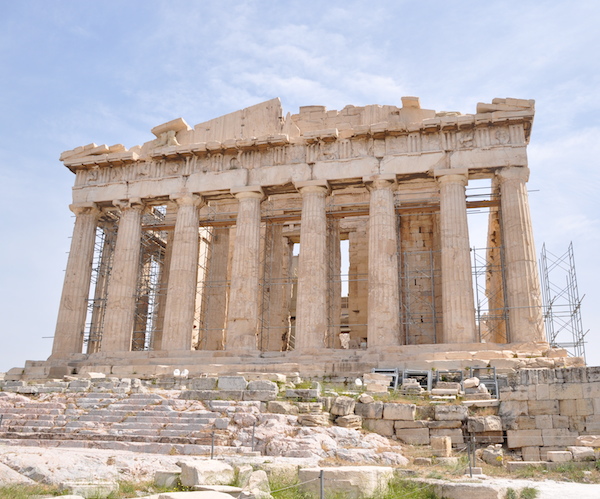
Supervised by the great artist, Phidias (who also was tasked with creating the sculptures), construction started in 447 BC and was fully finished (structure and decorations) 16 years later. Some of the stones are from nearby Mount Pentelicus and were some of the most costly stones acquired and transported during the build.
While the Parthenon has been everything from a temple, treasury, church, and mosque, one of the most magnificent things that stood underneath her roof was the iconic 42 foot statue of Athena, the patron goddess of the city – the protector of Athens.
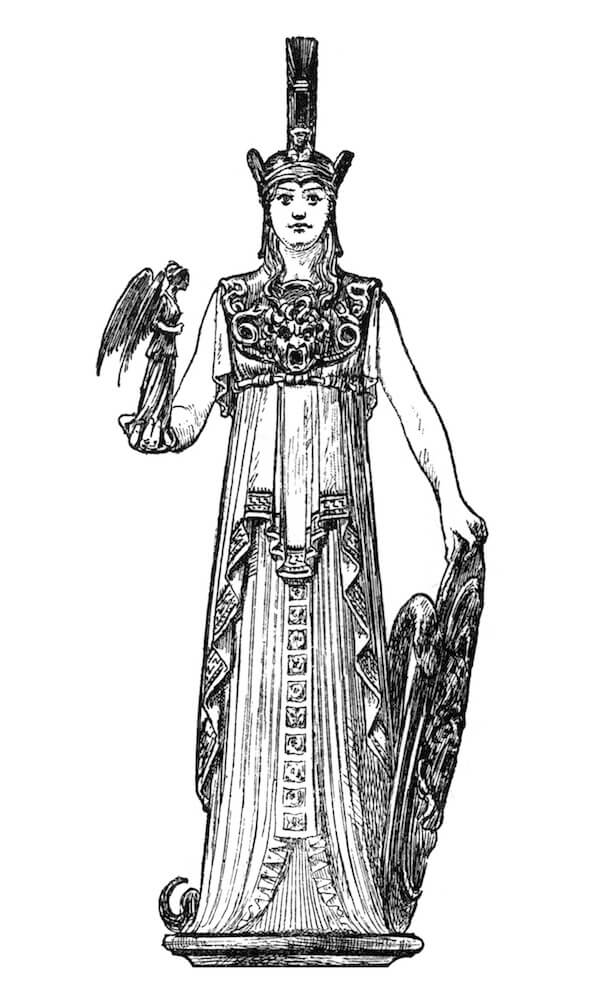
We have a general idea of what the statute actually looked like thanks to, Pausanias, an ancient historian:
The statue itself is made of ivory and gold. On the middle of her helmet is placed a likeness of the Sphinx … and on either side of the helmet are griffins in relief. … The statue of Athena is upright, with a tunic reaching to the feet, and on her breast the head of Medusa is worked in ivory. She holds a statue of Victory about four cubits high, and in the other hand a spear; at her feet lies a shield and near the spear is a serpent. This serpent would be Erichthonius. On the pedestal is the birth of Pandora in relief.
Unfortunately, it was removed in the 5th century AD by the Romans. There is a life size replica of this statue, located in Tennessee (USA), that is an identical copy built to size and based off research and descriptions. It’s a thing of beauty:
Some of the metopes can still be seen on the top of the Parthenon. There were originally 92 marble sections depicting different images of Greek history. The east side, the final images of the battle between the Gods and the Giants. The south, the battle of the Lapiths and Centaur. On the west, the invasion of Athens by the Amazons. The north showed images of the Greeks taking Troy.
Most of them have either been distorted over time, or taken. Fifteen from the south wall were removed and are now housed in the British Museum. There is some controversy surrounding these “Parthenon Marbles,” as they have been labeled, which you can look more into if you like.
As you make your way pass the Parthenon, you’ll notice a Greek flag and lookout point straight ahead of you in the very back. Coming to this section reveals gorgeous views of the city and is a popular point to take pictures of not only your surroundings, but also of yourself, family, or friends.
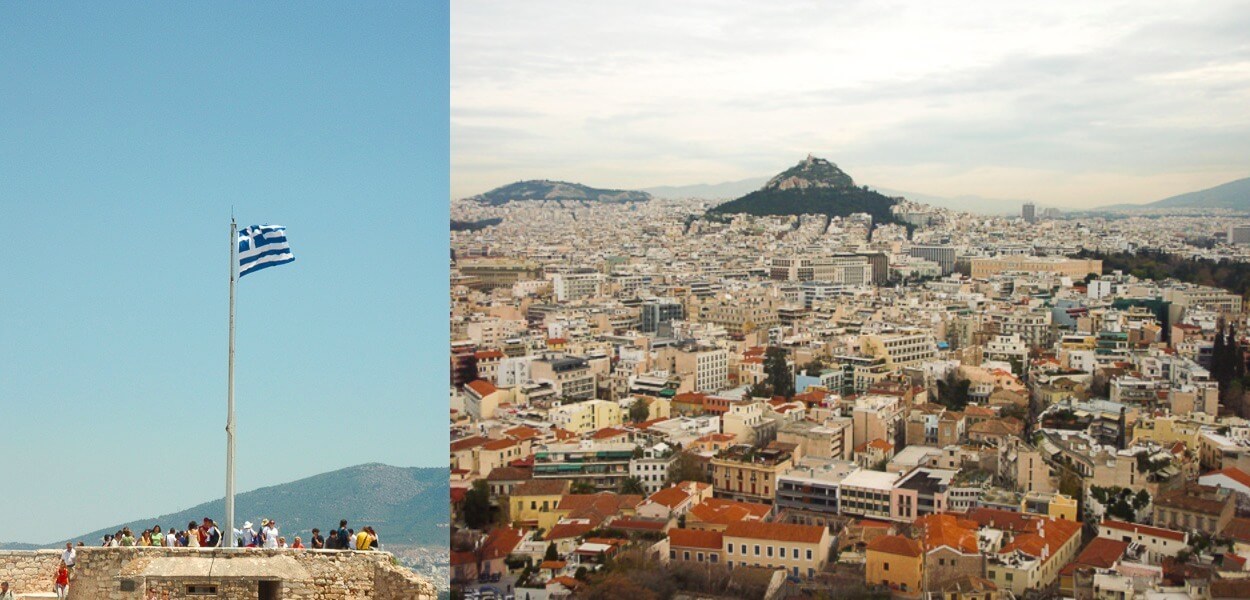
Between this point and the Parthenon, there once stood two temples, on the right side, not much is known, and the left, an open aired sanctuary for Zeus. It isn’t there anymore and not much else is known about it.
Now, with your back to the lookout point, you’ll see the Erechtheion to your right. Let’s head in that direction. If you were to make this walk as Plato and Aristotle once did, there would have been an altar between you and the Erechtheion dedicated to Athena as well (taking a bit of liberty with this sentence as I couldn’t find when it was destroyed). Today, it is no longer present.
As you come to this location, you may notice the remains of another building, this is because at one time, two buildings existed. The Erechtheion, which stands today, and in front of that, those ruins between the Erechtheion and the Parthenon once created the Old Temple of Athena, sadly, it was destroyed by the Persians in 480 BC.
The Erechtheion (Ἐρέχθειον) is yet another remarkable building and one that I feel people recognize by the women columns.
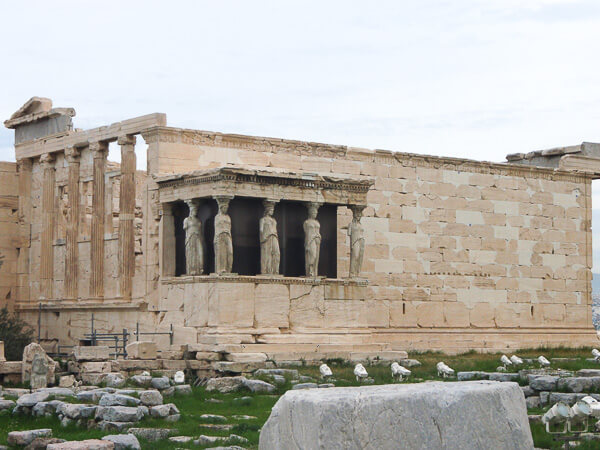
The building that stands today was build between 421 and 406 BC and was a temple dedicated to Poseidon and Athena. The sculptor and mason for this temple was, Phidias, who had been in charge of the Parthenon as well. This temple is said to have replaced a previous temple to Athena that was destroyed by the Persians in 480 BC.
This structure erected entirely of marble from Mount Pentelikon, which was the case with other buildings in the Acropolis.
Going back to those iconic women columns, in the front, they are known as, “The Porch of the Caryatids.” These beautiful statues are actually serving a very specific purpose. Beyond being the supporting columns, as what caryatids were primarily use for, the statues were actually built to hide a 15-foot support beam that was placed in during construction. Why you may ask? Due to the onset of the Peloponnesian war (the fight between Athens and Sparta), the building had to be greatly reduced in size to fund the war efforts, so they added a support beam and built it much smaller than originally planned.

After that, your tour of the Acropolis hilltop would be somewhat complete. I would recommend walking around another time or two to really take everything in.
There are however just two MORE things I want to touch on that are not including in the hilltop section of the Acropolis, but are apart of it nonetheless. They are on the south slope and can either be looked down upon as you are walking up to the entrance of the Acropolis or seen before going up the hill.
The first is the very well preserved, Odeon of Herodes Atticus:

This theater was built by the wealthy Athenian Herodes Atticus and dedicated to his wife, Aspasis in 161 AD. At its creation, it was a three level amphitheater that held 5,000 Greeks. It was used as a venue to host popular music performances – something that is still done to this day.
The loss of the roof and other features were at the hands of the Heruli, an eastern Germanic tribe during a raid in 267 AD.
The Second theater, and the one with more historical significance is the, Theatre of Dionysus
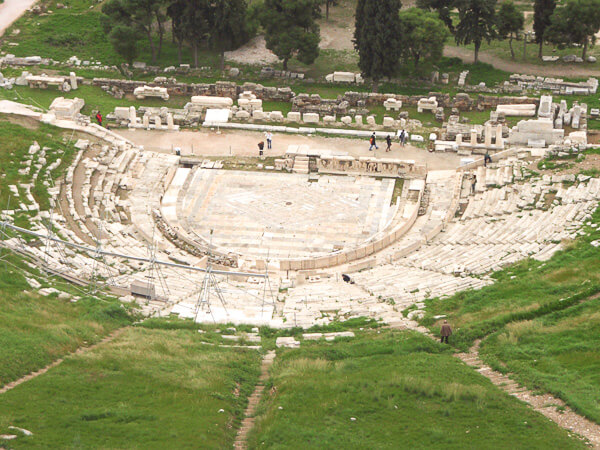
A grand theater in its time, it’s one of the earliest preserved theaters in Athens and dates back to the 5th Century BC. It was said in ancient times to have been built by the very god it is dedicated to, Dionysus. The theater was used for festivals to honor him, plays, and in its prime, it sat 17,000 people.
Dionysus, being the god of wine and drama, invoked the love and passion for theater that we know the ancient Greeks enjoyed so much. Some of the dramatist who had their plays acted out in this very theater were: Aeschylus, Sophocles, Euripides, Aristophanes, and Menander.
I would recommend, walking down to it and checking it out – I feel like the Greek tragedy was born in this theater.
Lastly, I wanted to close with an overall map of the Acropolis so you can see all the buildings that once stood:
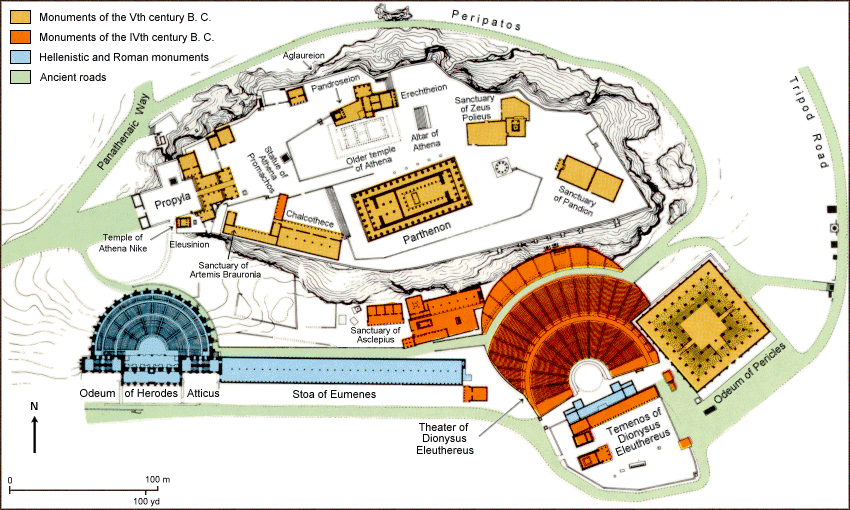
RESOURCES
I want to point out that there is almost unlimited information about the buildings you’ll see while visiting the Acropolis. What I presented here were brief facts and some personal opinions. I encourage you to check out some of the following books if you would like to dig a little deeper into the history of Acropolis and the people who helped build it.
Can’t make it to Greece anytime soon? There is a wonderful website that has a beautifully done FREE virtual walkthrough of the Acropolis. They even take you inside the parthenon, something you wouldn’t be able to do. So, whether you’ve been there or not – I recommend spending some time and doing it. It can be found here: Virtual Tour of The Acropolis
Acropolis Museum:
In 2009, the brand new Acropolis Museum opened. It revolves around the Acropolis, and you can see statues and artwork that hasn’t been viewed since ancient times. It’s a remarkable museum, packed with history and artifacts. You even walk over ruins as you enter the museum that are visable via the glass floor. It’s a must if you’re in Athens! Also, their cafe is delicious and was given high marks for there food, so that a plus – and your view is the Parthenon!
Thanks so much for taking the time to read this gigantic post. Both Jane and I thoroughly hope you enjoyed it!
Until next time,
Kenton
Sources: I pulled the facts from my own knowledge and the Wikipedia pages that correspond to each building. The pictures are either mine or thought to be in the public domain. The map of the Acropolis at the end is credited to: plato-dialogues.com, Temple of Athena Nike is credit to Wikipedia and the replica of Athena statue to Wikipedia.


